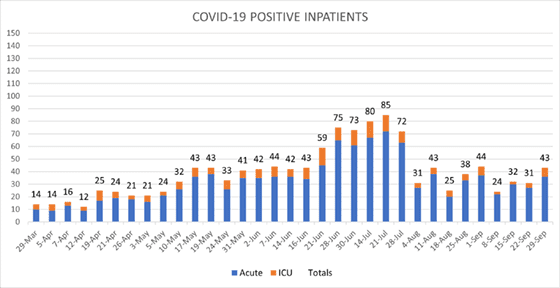QUICK READ:
- Viral infections are on the rise as kids return to school and day care.
- We expect to see more COVID-19 activity as the weather gets colder and people spend more time indoors.
- Now is a great time to get the updated COVID-19 booster shot and your annual flu shot; it is safe to get both at the same time.
- Our Med Tech team continues to review last week’s updated infection control guidance for health care settings from the CDC.
I am often asked where we are in the pandemic and where it might be going. When I think about how to answer, I first try to re-frame the question. Recently, an ID colleague of mine, Dr. Celine Gounder, wrote that people often conflate the pandemic as an infectious disease and the human response to the pandemic. When someone says the pandemic is over, what they usually mean is that our response to the pandemic is over or is fading to the background. This may or may not be true.
The challenge is that the pandemic as an infectious disease continues to cause infections, suffering, and death at a level that is unprecedented in most of our lives. And this will continue to challenge us as we head back indoors this fall and winter, often without the mitigations we relied on the last two years.
In fact, only a few weeks into the new school year, we’re already seeing a surge in viral infections. Seattle Children’s Hospital this week, for example, reported patient volumes at an all-time high and “unprecedented demand” for emergency department services driven largely by a regional uptick in viral and respiratory illnesses.
In our new reality, the most common viral infections — the ones that cause the colds and flu that spread when our kids go back to school and day care — share many symptoms with COVID-19. They all can look like COVID-19. Often the only way to tell for sure is by testing, sometimes repeatedly.
Right now, King County’s COVID-19 community level is in the “low” tier based on case counts, but we know we are missing most COVID-19 infections and tests. The county’s transmission level remains “high” due to the combination of infections and the impact on healthcare facilities. Regardless of what level we assign the situation, we appear to have reached a low point in COVID-19 cases.
Looking ahead, we should expect to see more viral infections, including an increase in COVID-19, as the weather gets colder, the days shorter, and we spend more time indoors. Our best models project this trend and other parts of the world are already seeing it happen. The U.K., for example, recently registered its first rise in COVID-19 infections since July — an increase that officials there also attributed to schools returning to session. The UW Institute for Health Metrics and Evaluation (IHME) recently updated their forecasts indicating an increase in COVID-19 cases into December and hospitalizations increasing through the end of the year. We also need to keep an eye on emerging variants that have the potential to be more infectious and/or to be more immune evasive. New variants have emerged roughly every three to six months, and we should assume this pattern will continue.
In the meantime, we will continue to do our best to protect ourselves and our patients. Last week, the Centers for Disease Control and Prevention (CDC) updated its infection control guidance for healthcare settings. Our Med Tech team is reviewing those guidelines, but no changes have been made to our protocols at this time.
UW Medicine COVID-19 Activity Summary

Local/National/Global Epidemiology
King County: Public Health – Seattle & King County is reporting 516,654 total cases and 3,193 deaths as of Thursday, Sept. 29. The number of new positive tests over the past seven days is currently at 112.1 per 100,000 people.
Washington: The Department of Health reports 1,813,501 cases and 14,312 deaths as of Sept. 27.
United States: The Centers for Disease Control and Prevention reports 50,397 new cases, 95,972,697 total cases and 1,051,949 deaths as of Sept. 28.
Global: The WHO COVID-19 Dashboard reports 613,942,561 confirmed cases and 6,520,263 deaths as of Sept. 29.
Despite the overall increase in viral infections locally, our COVID-19 key metrics remain in a manageable range. Now is a great time to get the updated COVID-19 booster and your annual flu shot. It’s safe to get both at the same time, and it’s the best thing you can do to protect yourself and your loved ones from serious illness in the months ahead. If you have put your mask on the shelf, now is a good time to start wearing it again in indoor public spaces. If you are going to spend time in indoor public spaces, look for those with good ventilation. Use everything we have learned over the last several years to keep yourself and those around you safe.
I happened to get my booster last Sunday at Harborview. Thanks to the team there who made the process fast, easy and efficient, and to all of you who continue to help with our vaccination efforts across the region. Your work is protecting us all, saving lives, and making a difference.
Sincerely,
John Lynch, MD, MPH
Medical Director, Infection Prevention & Control
Associate Medical Director, Harborview Medical Center
Division of Allergy & Infectious Diseases, UW School of Medicine

